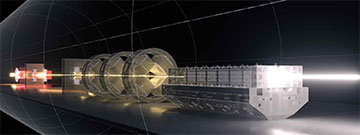Researchers in the United Kingdom and the United States have simulated the generation, transport and conversion into X-rays of energetic electrons accelerated in a plasma wakefield device, confirming that the electrons’ energy spread and emittance remain largely unchanged—which would allow production of exceptionally brief hard X-ray pulses. [Image: University of Strathclyde / Science Communication Lab] [Enlarge image]
Plasma accelerators could generate electron beams orders of magnitude brighter and over far smaller distances than the handful of gigantic free-electron lasers (FELs) operating in the world today. That is the conclusion of collaboration led by a research team in the United Kingdom, which has carried out an end-to-end simulation of an FEL powered by a plasma-wakefield device in which the accelerated electrons are extracted from gas within the plasma—a setup that the team calculates could yield coherent hard X-ray pulses each just 100 attoseconds long (Nat. Commun., doi: 10.1038/s41467-023-36592-z).
Smaller and cheaper accelerators
FELs generate much sought-after high-frequency light by sending very energetic electrons through a device known as an undulator. This alternating series of magnets forces the electrons to oscillate and emit bursts of photons, which in turn cause the electrons to bunch up at the scale of the emitted wavelength. With the radiated power thereby increasing exponentially along the undulator, the result is a series of exceptionally bright flashes of coherent radiation.
This process relies on electrons that not only are highly energetic but also have a very narrow range of energies, positions and momenta. Existing FELs achieve these objectives by accelerating electrons inside radiofrequency cavities. But there is a limit to the strength of the electric fields that these cavities can support before their walls start to break down, which places a cap on the accelerating gradient—meaning that the accelerators have to be very long (up to several kilometers) and also very expensive (the latest costing more than US$1 billion).
Plasma accelerators promise to be far smaller and cheaper, thanks to their vastly higher electric-field gradients. The gradients are set up when energetic particles or laser pulses are sent through a plasma, pushing plasma electrons aside and very fleetingly leaving a positively charged region in their wake. That region becomes negative a moment later when the electrons rush back in, then positive again as they overshoot—yielding a wave in the plasma along which other electrons can be accelerated (see “Surfing the Wakefield,” OPN, February 2022).
Scientists have achieved tens of gigavolts per meter in this way, but thus far, they haven’t been able to match the beam quality possible with conventional accelerators—having been unable to limit both energy spread and emittance (energy and transverse momentum distribution) to the necessary levels simultaneously. The result has been plasma-powered FELs that can generate either incoherent radiation up to soft X-ray wavelengths or a coherent output in the extreme ultraviolet region.
Brighter electron beams
In 2019, researchers from the University of Strathclyde, UK; the SLAC National Accelerator Laboratory, USA, and elsewhere showed how beam quality might be improved by changing the source of accelerated electrons. Their “Trojan horse” technique involves exploiting “cold” electrons released within the plasma wave by ionizing a background gas with a laser pulse, rather than injecting “hot” electrons from outside the plasma. Working at SLAC’s FACET facility, they used different laser pulses to ionize hydrogen atoms to create the plasma and helium atoms to generate the cold electrons.
Hidding and colleagues found that it should be possible to generate electron beams many orders of magnitude brighter than even the brightest from radiofrequency devices, and then extract, isolate and transport those beams without any significant degradation in energy spread or emittance.
Now a part of that collaboration, led by Bernhard Hidding and Fahim Habib of the University of Strathclyde, has gone on to work out whether the refined properties of such internally generated electrons can be maintained as the electrons are tapped to produce X-rays. The researchers’ computer simulation involved generating an additional beam of electrons to overlap the main beam and minimize its energy spread before dumping the former and then directing the latter through an undulator.
Hidding and colleagues found that it should be possible to generate electron beams many orders of magnitude brighter than even the brightest from radiofrequency devices, and then extract, isolate and transport those beams without any significant degradation in energy spread or emittance. The undulator output, they conclude, would be coherent X-ray pulses with wavelengths of less than an Angstrom and durations of around 100 attoseconds (equal to 10-16 s), which would reach maximum brightness after just 10 m of electron oscillation.
Future directions
The researchers suggest that such brief, short-wavelength pulses could find a range of applications in fundamental science, medicine and industry. For example, they say, it would be possible to image the motion of electrons on their natural time and length scales—allowing the study of ultrafast charge transfer in biomolecules and chemical reactions.
As to such an FEL’s size, Hidding and co-workers say it could potentially extend to just a few tens of meters if the electrons used to create the wakefield themselves come from a plasma device—one that creates its wakefield using a laser rather than a particle accelerator. They point out that the electron beams from such laser wakefield accelerators have far higher energy spreads and emittances than those from radiofrequency linear particle accelerators, but they argue that those beams, while unsuited to hard X-ray production, are adequate as input to another plasma device.
Indeed, they reckon that such a tandem plasma accelerator might allow hard X-ray FELs to be used “ubiquitously as diagnostics for probing plasma, nuclear or high energy physics”—potentially being sited in medium-sized university labs and university hospitals. But they caution that realizing the technology in practice will require several more years of work.

